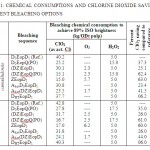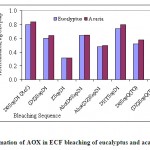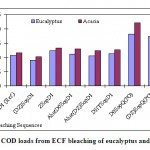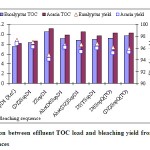Effluent Loads From Different ECF Bleaching Sequences Used In Hardwood Kraft Pulp Bleaching
Md. Rezaul Karim1 *
1
Department of Chemistry,
Chittagong University of Engineering and Technology,
Chittagong,
4349
Bangladesh
Corresponding author Email: rezaulkarim68@yahoo.com
DOI: http://dx.doi.org/10.12944/CWE.6.2.01
Effluent loads from different traditional and emerging ECF bleaching sequences were investigated. Oxygen delignified Eucalyptus camaldulensis and Acacia mangium kraft pulps having similar kappa number, ca 12.0 were used in this study. Different ECF bleaching sequences were compared with reference sequence, D0EopD1 in terms of effluent load, such as AOX, COD and TOC. Depending on the nature of sequences 6.0 to 63.0% chlorine dioxide consumption was reduced and as a result the amount of AOX formation was also reduced. The effluent from sequences (DZ)EopD1, DHTEopD1, AhotD0EopD1, Ahot(DZ)EopD1 and ZEopD1 showed marginally higher COD and TOC in comparison with reference sequence, D0EopD1. Sequences like, D0EopQ(PO) and (DZ)EopQ(PO) having (PO) instead D1 of reference sequence reduced AOX in effluent substantially; but COD and TOC loads were increased. In all cases acacia gave marginally higher effluent loads compared to eucalyptus.
Copy the following to cite this article:
Rezaulkarim MD. Effluent Loads From Different ECF Bleaching Sequences Used In Hardwood Kraft Pulp Bleaching. Curr World Environ 2011;6:201-206 DOI:http://dx.doi.org/10.12944/CWE.6.2.01
Copy the following to cite this URL:
Rezaulkarim MD. Effluent Loads From Different ECF Bleaching Sequences Used In Hardwood Kraft Pulp Bleaching. Curr World Environ [serial online] 2011;6:201-206. Available from: http://www.cwejournal.org/?p=166
Download article (pdf)
Citation Manager
Publish History
Select type of program for download
| Endnote EndNote format (Mac & Win) | |
| Reference Manager Ris format (Win only) | |
| Procite Ris format (Win only) | |
| Medlars Format | |
| RefWorks Format RefWorks format (Mac & Win) | |
| BibTex Format BibTex format (Mac & Win) |
Article Publishing History
| Received: | 2011-07-18 |
|---|---|
| Accepted: | 2011-08-25 |
Introduction
Due to environmental reason the use of elemental chlorine in pulp bleaching has been totally eliminated in most of the countries in the world. In the early 90's bleaching technology switched from elemental chlorine to chlorine dioxide based bleaching and reduced the formation of absorbable organic halogens (AOX) substantially; but still needs to improve. That is why researchers are looking for new bleaching technologies for further reduction of effluent load. To achieve the expected goals, researchers prefer more environmentally friendly bleaching chemicals, like ozone and hydrogen peroxide. Chlorine dioxide in prebleaching and in final bleaching stages are being partly or fully replacing by ozone and hydrogen peroxide respectively. Environmental benefits were achieved from the replacement of chlorine dioxide by ozone in prebleaching in laboratory studies.1,2 Homer et al.3 reported a reduction of 65% AOX in effluent when ozone utilized in combination with chlorine dioxide. The modification of a Do stage into (DZ) reduced bleaching chemical cost whilst maintaining pulp quality and reduced AOX in effluent due to the lower chlorine dioxide charge.4 In some cases the consumption of chlorine dioxide is reduced by placing a hot acid pretreatment stage just before chlorine dioxide prebleaching or by performing chlorine dioxide stage at elevated temperature.5 In the present work, eight different elemental chlorine free (ECF) bleaching options including the traditional sequence, which was considered as reference were evaluated for Eucalyptus camaldulensis and Acacia mangium kraft pulp bleaching. These two hardwood species are being considered as the most potential raw material for bleached pulp production in Southeast Asia and as well as in other Asia.
Materials and Methods
Eucalyptus camaldulensis and Acacia mangium were collected from kraft pulp mills of Thailand and Indonesia respectively. Chips were cooked to get pulp with kappa number ca 20. Then the kappa number was reduced to ca 12 through oxygen delignification process. Both pulps were then prebleached with chlorine dioxide D0, ozone Z, chlorine dioxide in combination with ozone (DZ), chlorine dioxide at elevated temperature (DHT), hot acid treatment before D0 and (DZ) i.e., AhotD0 and Ahot(DZ) followed by alkaline extraction with oxygen and hydrogen peroxide reinforcement (Eop). All prebleached pulps finally brightened using chlorine dioxide (D1) stage. D0 and (DZ) prebleached pulps also were brightened with pressurized hydrogen peroxide (PO) stage. (PO) stage was followed by a chelation stage, Q. So, a total of eight ECF bleaching sequences, like D0EopD1 (reference), (DZ)EopD1, ZEopD1, AhotD0EopD1, Ahot(DZ)EopD1, DHTEopD1 D0EopQ(PO) and (DZ)EopQ(PO) were evaluated in this study. In all cases chemical charges were maintained in such a way so that the target brightness 89% ISO was achieved.
For a given bleaching sequence effluent samples were collected separately from the washing filtrates of prebleached, extracted and finally brightened pulps. Same amount of washing water for each ton of OD pulp was used for every stage of all pulps. Effluent COD load was measured according to standard methods for the examination of water and waste water.6 Total organic carbon (TOC) content of effluent was determined according to same standard by using TOC analyzer, model VCSN. COD and TOC loads were measured individually for each stage and then added them together to obtain total load for a certain bleaching sequence. AOX in effluent was not determined directly in this study, but approximate amount for each bleaching sequence was calculated using the following equation according to Johnston et al.7:
AOX (kg/ODt pulp) = (0.1 X ClO2 in kg as active Cl)/5.
Result and Discussion
Chlorine Dioxide Consumption
Chemical charges to different bleaching sequences and percent reduction of chlorine dioxide in other sequences compared to reference sequence, D0EopD1 are presented in Table 1. (DZ) EopD1 was able to save about 26% of total chlorine dioxide consumed by the reference sequence. The replacement of chlorine dioxide stage with pressurized peroxide stage in final brightening, i.e. D0EopQ(PO) and (DZ)EopQ(PO) resulted 35% and 60% reduction in chlorine dioxide consumption respectively. A considerable reduction of chlorine dioxide was found from the placement of hot acid treatment (Ahot) before prebleaching. Chlorine dioxide treatment in prebleaching at elevated temperature (DHT) was not able to bring much benefit in term of chlorine dioxide saving.
The reduction of chlorine dioxide consumption in bleaching is more fruitful as most of the chlorinated compounds are formed in this stage. Chlorinated phenolics are the biggest threat. When chlorine dioxide reacts with hexenuronic acids (HexA) probably no chlorinated compounds are formed. If any chlorinated compounds are formed from HexA, those are not aromatics; those are simple, less dangerous than chlorinated phenolics. At similar kappa level acacia pulp always contains more lignin than eucalyptus pulp; as acacia pulp contains lesser amount of HexA. In lignin reactions always some chlorinated phenolics are formed and is thus more “dangerous”. As in the present study acacia pulp contained higher amount of lignin compared to eucalyptus pulp, there is a possibility to produce higher amount of chlorinated phenolics in chlorine dioxide prebleaching. Therefore, a reduction of chlorine dioxide in bleaching surely reduces chlorinated phenolics formation and thereby reduces the toxicity of effluent generated in a bleaching plant. The implementation of ECF technology in pulp bleaching has reduced organochlorines formation tremendously compared to elemental chlorine based bleaching. However, the formation of toxic dioxins in ECF bleaching has not been totally eliminated. Swedish researchers7 have reported detectable level of toxicologically polychlorinated dibenzo-p-dioxins (PCDDs) and polychlorinated dibenzofurans (PCDFs) in the effluent from mills that use ECF bleaching. The reduced use of chlorine dioxide in prebleaching and final bleaching would have surely the positive impact on chlorinated organics formation, though those toxic chemicals were not determined in this study.
 |
Table 1: Chemical consumptions and chlorine dioxide savings in different bleaching options Click here to View table |
Absorbable Organic Halogens (AOX)
The amounts of AOX in bleaching effluent which were calculated directly from total chlorine dioxide consumption in different bleaching options are illustrated in Fig.1. In general, AOX formation in an ECF bleaching sequence increases with increasing consumption of total chlorine dioxide. In practice, ECF bleaching is not free of elemental chlorine. So, the sequences consumed higher amount chlorine dioxide also produced higher amount of AOX. As shown in Fig.1, all the sequences except DHTEopD1 brought more or less benefits over reference sequence D0EopD1 in term of AOX formation. A significant reduction of AOX was reported from the sequential application of D and Z in (DZ), which was resulted partly due to reduced use of chlorine dioxide and partly due to the oxidation reactions between ozone and chlorinated compounds formed in Do stage.8 Therefore, the effluents from the sequence containing (DZ) in prebleaching should contain lower amount of AOX than that as calculated.
 |
Figure 1: Formation of AOX in ECF bleaching of eucalyptus and acacia kraft pulp Click here to View figure |
Commercial chlorine dioxide generators in many cases co-generate molecular chlorine, and chlorine is formed in reducing reactions of chlorine dioxide. Prebleaching stage of a conventional ECF bleaching sequence is the major source of AOX. Because incoming pulp to the prebleaching stage contains higher amount of lignin compared to the pulp entering in to the following bleaching stages. It is well defined that AOX forms indirectly when chlorine dioxide reacts with residual lignin in pulp. In fact, the reaction between chlorine dioxide and lignin produces chlorite and hypochlorous acid simultaneously. At low pH hypochlorous acid converts in to chlorine and this chlorine is responsible to AOX formation. However, the actual amount of AOX in effluent resulted from a sequence must be considerably lower than that as calculated. In calculation AOX was calculated out simply on the basis of total chlorine dioxide consumption to a certain sequence. Most of the AOX forms in D0 stage due to higher lignin content of pulp and as well as higher chlorine dioxide charge. On the other hand, almost negligible amount of AOX is formed in D1 due to very low lignin content of pulp. In this study 0.3 to 0.8 kg/ODt pulp AOX was calculated for the ECF sequences studied. Typical AOX levels in ECF bleach plant effluent is 0.9 to 1.7 kg/ADt pulp.9 In a standard bleach plant like D(EO)DD, the figure is even below 0.5 kg/ADt and in modern ECF bleach plant the value is as low as 0.1 kg/ADt after biological treatment.10
The contribution of residual lignin and HexA on AOX formation in prebleaching (D0E) was studied.11 This study confirmed that the amount of AOX formed in prebleaching is incoming kappa number dependent. They also reported HexA as the major contributor of AOX in prebleaching effluent, but this AOX is unstable upon storage. AOX originated from Klason lignin is stable.12 Thus, the effluent from acacia pulp bleaching in this study should contain lower unstable, but higher stable AOX compared to the effluent from the bleaching of eucalyptus pulp; in acacia pulp HexA content was substantially lower and lignin content was considerably higher than in eucalyptus pulp when both pulps have similar kappa number.13 According to that study 42.5% and 34.7% of total kappa number were contributed by HexA in oxygen delignified eucalyptus and acacia pulp respectively.
Chemical oxygen demand (COD)
Effluent COD load is another important parameter that also be considered when pulps are bleached. COD loads from different ECF bleaching sequence are shown in Fig. 2. Partial replacement of chlorine dioxide with ozone (DZ) in prebleaching gave very marginal benefit over Do. Ahot or DHT was unable to bring any benefit in effluent COD load when compared with D0 or (DZ). Replacement of D0 completely with Z in prebleaching gave higher COD load to the effluent. A considerable higher COD load was observed when (PO) was applied in the final stage instead of D1.
 |
Figure 2: Effluent COD loads from ECF bleaching of eucalyptus and acacia kraft pulp Click here to View figure |
COD load to the effluent depends on the kappa number of pulps entering in to the bleach plant. So, the higher the incoming kappa numbers the higher effluent COD load. Bleaching of acacia pulp resulted in little higher COD load to effluent compared to eucalyptus pulp in all cases. This is logical, because lignin kappa of acacia pulps was 1 unit higher than that of eucalyptus pulp while both of the pulps have similar total kappa number after oxygen delignification.13
Total Organic Carbon (TOC) and Bleaching Yield
In the bleaching of pulp, TOC load in effluent and bleaching yield are closely interrelated. Cellulose, as well as organic matters loss in bleaching operation decreases bleaching yield and increases effluent TOC load. In this study a clear relationship was found between TOC in effluent and bleaching yield (Fig. 3). Highest TOC in effluent and lowest bleaching yield was resulted from 100% replacement of chlorine dioxide with ozone in prebleaching. Major environmental benefits from ozone come when it totally replaces chlorine dioxide in D0 stage and allow the recovery of effluents.
For a certain pulp sample, 100% Z in prebleaching resulted in about 35% more TOC compared to D0. (DZ) gave slightly higher TOC in discharges because of yield loss compared to reference option D0. Ahot or DHT lost yield in bleaching and hence, an increment of TOC in effluent was found compared to D0 or (DZ). The application of Q(PO) in place of D1 in final bleaching resulted more carbohydrates loss and thereby the effluent got more organic carbon, which was measured as high TOC content. In the bleaching, acacia pulp contributed 0.5 to 1.0 kg/ODt more TOC to the effluent than that of eucalyptus.
 |
Figure 3: Relation between effluent TOC load and bleaching yield from different ECF bleaching sequences Click here to View figure |
In the bleaching, yield loss is one of the most important cost items. (DZ) at 40% replacement resulted 0.3-0.4% less yield and 100% replacement decreased yield by ca 1% unit compared to D0. Ahot and DHT in prebleaching or (PO) instead of D1 in final bleaching stage resulted considerable reduction in bleaching yield. Similarly as TOC, acacia gave lower bleaching yield compared to eucalyptus. Ventorim et al.15 reported 1% percent less yield in bleaching associated with about 4 kg TOC/ODt of pulp present in effluent.
Conclusion
Environmental loads from different ECF bleaching sequences were evaluated in this study. The study was run for two pulpwood species, Eucalyptus camaldulensis and Acacia mangium. The results were fairly similar. The environmental benefits from (DZ) compared to D0 was marginal. In the case of (DZ), the COD load was almost similar as D0, but AOX was reduced due to the reduction chlorine dioxide charges in prebleaching and D1. A considerable increment in effluent COD load was resulted from the 100% replacement of chlorine dioxide by ozone in prebleaching. Only 100% replacement of D0 with Z would allow the filtrates to the recovery cycle.
A marginal benefit on chlorine dioxide consumption was obtained from prebleaching options of AhotD0 and DHT and their other environmental impacts were negative compared to D0. The replacement of D1 with (PO) in the final bleaching was unable to bring benefits on TOC and COD loads to the effluent, though a huge amount of chlorine dioxide was saved. In this case, a considerable amount of AOX was reduced in effluent, yield loss was increased.
The evaluation of environmental impact is one of the major criteria to evaluate the applicability of a newly developed technology in the bleaching process. In a modern bleached kraft mill 50-90% of total discharges originate from the bleach plant. The environmental load of a selected bleaching technology must fulfill the requirements of environmental legislation in a specific country. Although the modern pulp mills, which are using a traditional ECF sequence able to meet the present environmental legislations in terms of effluent discharges in most of the countries in the world, but the regulations will be stricter in future.
References
- Colodette, J. L., Salvador, E., Shah, P. and de Brito, A. A. C., Appita J., 54 (2), 226 (2001).
- Toven, K., Doctoral Dissertation,Department of Chemical Engineering, Norwegian University of Science and Technology, Norway (2000).
- Homer, G., Johnson, S. and Epiney, M., In Proceedings of TAPPI Pulping Conference, 81. (1996).
- Chirat, C., In Proceedings of 53rd ATIP Annual Meeting, 7 (2000).
- Ragnar, M. and Lindstrom, M. E., Paperi Puu 86 (1), 39 (2004).
- APHA, AWWA and WPCE, Standard Methods for the Examination of Water and Waste Water. 20th Edition, Washington DC, USA (1998).
- Johnston, P. A., Stringer, R.L., Santillo, D., Stephenson A. D., Labounskaia, I. P., and McCartney, H. M. A., Technical report 7/96, Greenpeace Research Laboratories, University of Exeter, UK (1996).
- Chirat, C., Lachenal, D., Angelier, R., and Viardin, M. T., J. Pulp Paper Sci. 23 (6), 289 (1997).
- McKague, A. B. and Carlberg, G., Effluent characteristics and composition. In: Pulp Bleaching, Principles and Practice. Eds. C.W. Dence and D.W. Reeve. TAPPI Press, Atlanta. 749 (1996).
- Ragnar, R., Dahllof, H. and Lundgren, S., Appita J., 58 (6), 475 (2005).
- Bjorklund, M., Germgard, U., Jour, P. and Forsstrom, A., Tappi J. 1 (7), 20 (2002).
- Bjorklund, M., Germgard, U. and Basta, J., Tappi J, 3 (8), 7 (2004).
- Karim, M. R., Doctoral Dissertation, Pulp and Paper Technology Field of Study, Asian Institute of Technology, Thailand (2006).
- Ventorim, G., Collodette, J. L. and Eiras K. M. M., Nordic Pulp Paper Res. J. 20 (1), 7(2005).






